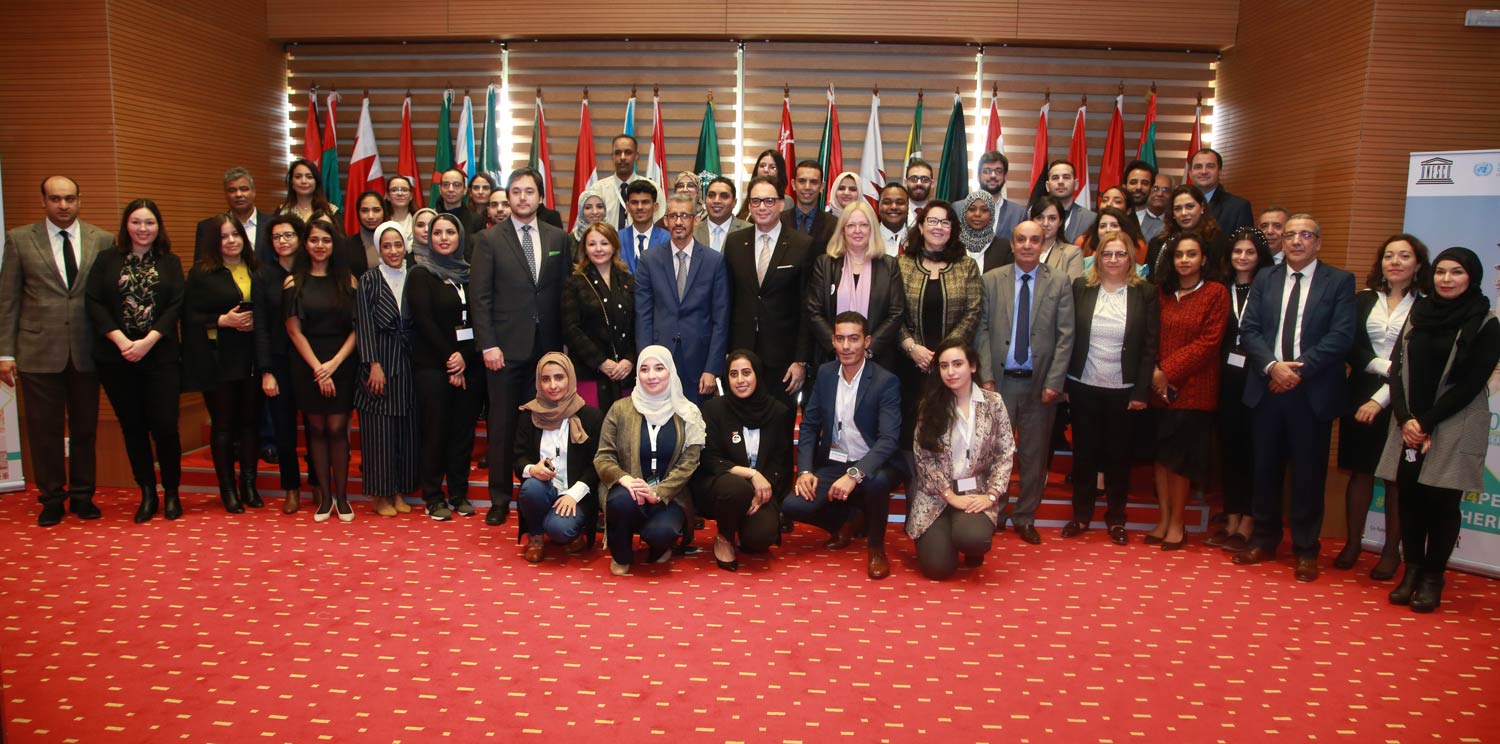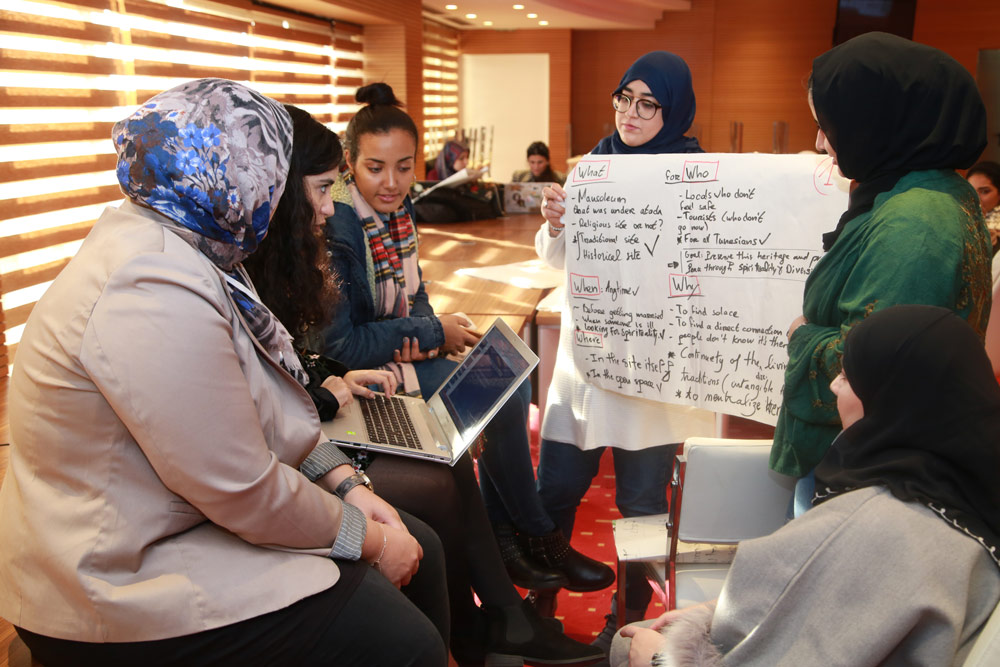"Youth for Peace, Youth for Heritage!"
say the young heritage professionals
in the Arab States region
© UNESCO / Participants brainstorming on the Emotion Design Approach
Thirty-two young professionals from 17 countries of the Arab States region gathered in Tunis, Tunisia from 2 to 6 December 2019 to participate in the Arab World Heritage Young Professionals Forum, to engage in their critical roles as global citizens towards peacebuilding through the protection, preservation and promotion of World Heritage.
These participants brought with them a diverse range of academic and professional backgrounds related to heritage and peacebuilding. Over five days they explored the concepts of violent extremism and its manifestation at heritage sites, followed by the processes of recovery and reconciliation, and the pivotal role that youth and the society as a whole can play in this process. As young professionals in the field they found a common vision for a future of peace in the region and discussed how culture can be leveraged to contribute to this future.

Opening Ceremony of the Arab World Heritage Young Professionals Forum © UNESCO (The Forum was opened by Dr Mohamed Ould Amar, Director-General of ALECSO; H. E. Ms Élaine Ayotte, Ambassador of Canada to UNESCO; Dr Mechtild Rössler, Director of the UNESCO World Heritage Centre; Mr Adel Elsayed Sparr, Head of the Youth Engagement Unit, UNOCT/UNCCT and H. E. Mr Mohamed Zinelabidine, Minister of Cultural Affairs of Tunisia)
Understanding violent extremism
As nations across the world grapple to arrive at a common description of violent extremism, the participants explored their own understanding of the term through the lens of their individual social contexts. They further studied the manifestation of violent extremism through the channels of hate speech, fake news and online extremism, among others.

Participants of the Forum discussing the factors leading to violent extremism © UNESCO
Heritage under threat and Preventing Violent Extremism (PVE) at heritage sites
The first-hand accounts on the loss of heritage to conflict and war, provided by the experts, struck a deep and personal chord with the participants and brought the realities of damage and destruction to the fore. It set the stage for the discussions that followed, and allowed the participants to understand the mechanisms and the push-and-pull factors that lead violent extremists to attack expressions of cultural identity.
Two visits to heritage sites in Tunisia that were under attack from extremist groups in the recent past, and the ways in which the communities addressed these attacks, helped bring in the local context. This led the participants to further reflect upon the methods of reconciliation and reconstruction they would opt for in similar situations.
Moving forward, they gained an overview of UNESCO's action to support its Member States in the protection of heritage from violent extremism, and in mitigating its impact.

Ms Fatma Jabberi Farroukh, Chief Architect at l’Institut National du Patrimoine, provided the participants with a background on the attacks that took place at the Mausoleum of Sidi Bou Said © UNESCO
Communicating about heritage for peace
Through three distinct case studies related to heritage sites the participants discovered the compelling Emotion Design Approach, which finds a way to draw a personal connection among the community, generations of their shared stories, and their heritage. Through this approach, the participants were able to leverage the powerful and unifying force of heritage in preventing violent extremism and in facilitating peacebuilding and reconciliation, which resulted in innovative communication plans for each of their case studies.

Participants brainstorming on the Emotion Design Approach ©UNESCO
To develop these plans, they broadened their scope of understanding of the challenges faced not just by heritage that is currently affected by conflict, but also by heritage that might have been under threat in the past or could potentially be in harm’s way in the future. They then worked together to find solutions for each of these scenarios. They developed projects that could possibly be implemented at or in relation to these sites, that ranged from educational and entertaining video games to week-long culture festivals.
Following the development of the communication plans, the participants met with Tunisian civil society organizations working in heritage and peacebuilding and presented their work. This also opened opportunities for networking and possible new collaborations.

Participants presenting their Communication Plans to the other groups as well as the civil society organizations © UNESCO
The bond between heritage, peace and youth

Participant Nassima Chahboun shares her views on the undeniable link between heritage and peacebuilding ©UNESCO
The varied subjects and formats covered during the Forum allowed for rich and extensive interactions between participants and experts, and the diversity of their professional and sociocultural backgrounds fostered cohesion and wider cultural understanding. The Forum was also the first initiative of its kind within the World Heritage Education Programme to address the link between heritage and peacebuilding, and their positive impact on one another.
Elie Saad, a participant, firmly believes that “society’s growth and development can only be achieved by consolidating the base upon which it was built, and heritage is that base”. Hala Al Sadi agrees, stating “cultural heritage is the glue that brings together communities, and in being so, it fosters a space of inclusion which is a pillar towards the prevention of violent extremism”. The participants agreed unequivocally that youth has a key role to play in the process, especially in undertaking preventive actions within heritage protection and preservation and mobilizing of communities. In addition to building a peer network of like-minded individuals committed to this common goal, the young professionals were enthusiastic about applying the knowledge and skills acquired during the Forum in their respective communities and countries. As expressed by Noor Alkamoosi, “to sustain the heritage management system, it is necessary to involve young people because they are the present who will preserve the past and build the future”.
Consolidating their learnings from the Forum and from each other, the young professionals developed an Action Plan including a set of recommendations for multiple stakeholders in the Arab States region, to build peace in the region through the protection, preservation and promotion of World Heritage. It can be accessed here:

Participant outlining the subjects for the Action Plan ©UNESCO
About the Forum
The Arab World Heritage Young Professionals Forum took place in Tunis, Tunisia, from 2 to 6 December 2019. It was organized by the UNESCO World Heritage Centre under the World Heritage Education (WHE) Programme, within the framework of the UNESCO/UNOCT project on the Prevention of Violent Extremism (PVE) through Youth Empowerment in Jordan, Libya, Morocco, and Tunisia, co-funded by Canada. The Forum was organized in collaboration with the Arab League Educational, Cultural and Scientific Organization (ALECSO), and l’Institut national du patrimoine (INP).

Participants at the Sidi Bou Said Mausoleum ©UNESCO



 Tunisia
Tunisia